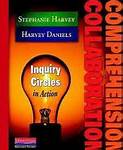I have had the privilege of working with a wonderful team of teachers. I am in the home stretch of my tenth year of teaching and I often will look back to my first years. I marvel at how little I really knew, but then feel blessed that my fellow colleagues had freely shared best practice instructional strategies.
Now, several years later, and a lot wiser, I understand the true purpose behind what we did. For example, in Science, our team leader developed a wonderful unit about the sun, Earth, and moon that required students to research self-selected questions and communicate new learning. Kids loved doing this then and continue to this day!
“Comprehension and Collaboration,” by well known authors Harvey Daniels and Stephanie Harvey, helped me understand the purpose, and rewards, of fostering collaboration in our classrooms. Reading this book came at just the right time for me since Wisconsin educators are looking at the new “Smarter Balanced Assessment” that their students will soon be taking. High school students will be expected to research a topic together and will be assessed on the outcome. I couldn’t wrap my head around it initially. (I was always one who did well on tests and I loved to demonstrate what I learned. My grade was in my own hands and this was reassuring to me.) That was until I read this book. The truth of the matter is that is what employers are looking for. They desire individuals who can collaborate and work together towards a common goal.
As a literacy coach in my district, I have led traditional book studies with teachers over the last few years. This year we went the non-traditional route. Our study was designed around the inquiry circle format to give teachers the experience of selecting questions they wanted answered about reader’s workshop, and then researching and collaborating to find the answers. This is just what students would experience.
What did the group decide to research about reader’s workshop? They wondered how to best structure their reader’s workshop block to meet the needs of all learners. They also wanted to learn more about about the schedules other middle school teachers from different districts have.
The last step in the process is “taking the learning public.” This isn’t really different than what we have done in the past. (O.k…well it is really different if you relied on question/answer type worksheets to assess student understanding…) Students are given the opportunity to choose a way to synthesize what they have learned and share it with those around them. Their audience could be fellow classmates or even the public. This crucial step prompts them to take what they learned, put it into their own words, and then gives them the freedom to choose a format that fits well with their learning styles. Tech savy kids can create videos or blog posts, visual learners can show of their creativity by making a poster. The possibilities are limitless.
Oh, and did I mention the number of Common Core Standards that inquiry learning addresses? It’s astounding. Because I don’t believe in everyone re-inventing the wheel in education, I am sharing the inquiry timeline/format that I created for the study in my district. I am also including some sample response options. Some are ones that belong to my students and others are ones that I created myself because I never just talk with others about something when I am presenting something new. I try it myself. Please feel free to contact me if you have any questions about the inquiry process.
Narwahls (Click on the link to the left to view an example of how a first grader synthesized her new learning and answered her guiding research questions.)
The above video is an example of how a visual learner might exercise their creativity and put together a project that outlines a reader’s workshop block to help viewers visualize the concepts being shared.
Sample Response Option Journal (Click on the link to the left to see another response option. This one is a journal entry in which I reflect upon how I have implemented reader’s workshop and how my understanding of reading instruction has developed and been refined over the past several years of my teaching career.)
2013MiddleSchoolBookStudy (1) (Click on the link to the left if you are interested in studying the book “Comprehension and Collaboration” by Harvey and Daniels and are interested in trying inquiry learning for yourself.)

